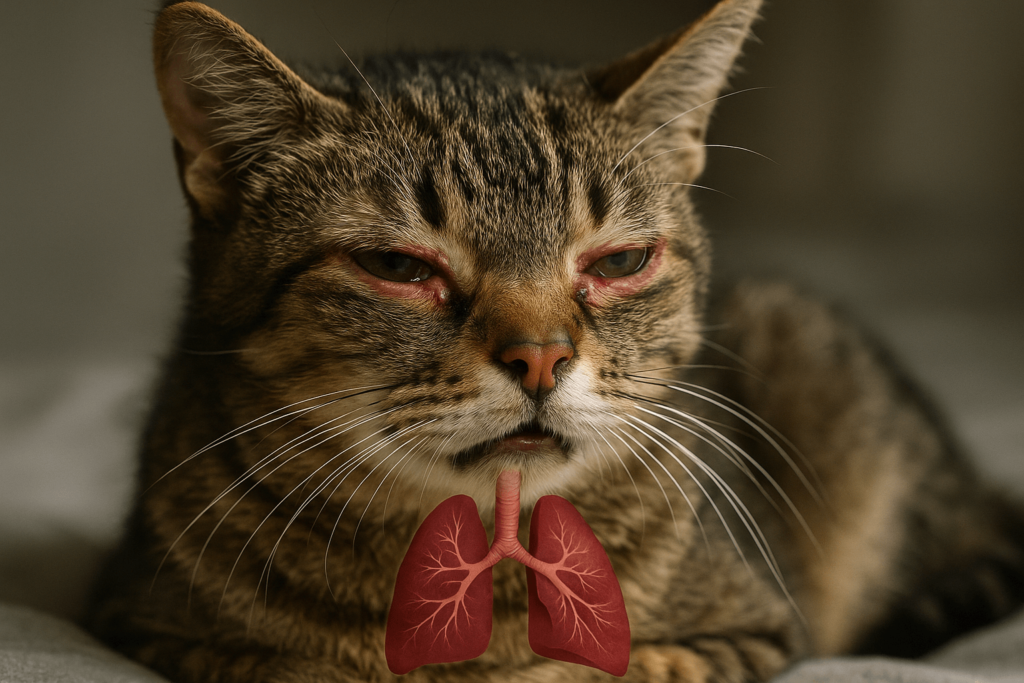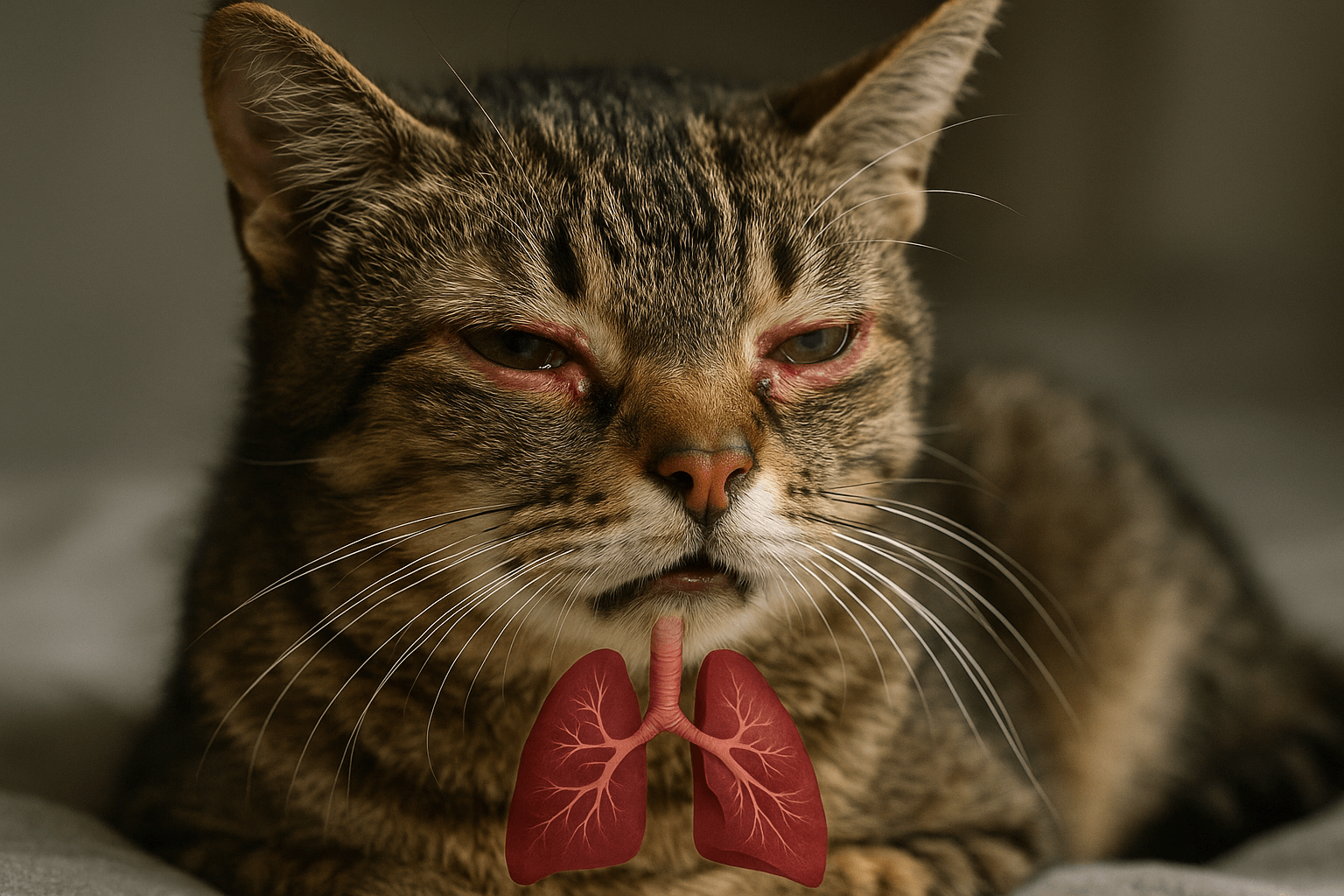Cat Lung Infection: Recognizing the Silent Signs Before It’s Too Late
A cat with a lung infection won’t tell you it’s sick. There are no dramatic cries or obvious collapses—just subtle changes: a slower purr, a slightly open mouth, a reluctance to leap onto the couch. By the time you notice, the infection may already be advanced. Cat lung infections are serious, often life-threatening, and easily mistaken for simple colds or aging. Understanding the signs, causes, and urgent care steps can mean the difference between recovery and tragedy.
Why a Cat’s Lungs Are So Vulnerable
Cats are masters of hiding illness—but their respiratory system doesn’t lie. When lungs are compromised, the body sends quiet signals. Here’s why lung health is critical:
Small Airway Structure:
Cats have narrow bronchial tubes, making them prone to blockages from mucus, inflammation, or foreign particles.High Metabolic Rate:
Their fast breathing and oxygen needs mean even minor lung impairment reduces energy and stamina dramatically.No Cough Reflex Like Humans:
Unlike dogs or people, cats rarely cough—so lung issues often go unnoticed until they’re severe.Exposure to Irritants:
Household smoke, dust, perfumes, and cleaning chemicals can trigger or worsen respiratory inflammation.Immune System Limitations:
Cats are obligate carnivores with unique immune responses that can struggle to fight off certain pathogens effectively.
A cat’s lungs aren’t just for breathing—they’re central to every ounce of vitality. When they falter, everything else follows.

Common Causes of Lung Infections in Cats
Not all lung infections are the same. Each cause demands a different treatment. Knowing the source helps you act faster.
Bacterial Infections:
Often secondary to viruses or dental disease, bacteria like Chlamydophila or Bordetella can invade the lower respiratory tract.Viral Origins:
Feline herpesvirus or calicivirus—common in shelters or multi-cat homes—can damage the airway lining, allowing secondary infections.Fungal Pathogens:
Cryptococcus or Aspergillus spores from soil or bird droppings can be inhaled, especially in humid climates.Parasitic Migration:
Lungworms or heartworm larvae can travel through the bloodstream and settle in the lungs, causing inflammation and fluid buildup.Aspiration Pneumonia:
Inhaling food, vomit, or medication during vomiting or improper pill administration can introduce harmful bacteria into the lungs.
Each cause requires precise diagnosis. Treating bacterial pneumonia like fungal pneumonia won’t work—and delaying the right treatment can be fatal.
Check this guide 👉Antibiotic for Cat Ear Infection: Best 7 Expert Tips!
Check this guide 👉Fungal Infection in Cats: Best 7 Expert Tips!
Check this guide 👉Cat Sinus Infection Treatment: Best 7 Expert Tips!
| Early Warning Signs | Advanced Symptoms |
|---|---|
| Slight increase in respiratory rate (over 30 breaths/min) | Open-mouth breathing or panting at rest |
| Mild lethargy or reduced playfulness | Blue-tinged gums or tongue (cyanosis) |
| Subtle nasal discharge (clear or slightly cloudy) | Fever above 103°F (39.4°C) |
| Reduced grooming or slight appetite drop | Coughing, wheezing, or gagging after eating |
| Avoiding high perches or jumping | Collapse, extreme weakness, or refusal to move |
How Veterinarians Diagnose Lung Infections
A cat won’t tell you it’s struggling to breathe. That’s why diagnosis requires expert tools and careful observation.
Physical Examination:
Your vet will listen to lung sounds with a stethoscope—crackles, wheezes, or muffled breaths indicate fluid or inflammation.Thoracic X-Rays:
The gold standard. X-rays reveal pneumonia, fluid buildup, masses, or foreign objects in the lungs.Bloodwork and CBC:
Elevated white blood cells signal infection. Low oxygen levels point to impaired lung function.Tracheal Wash or Bronchoalveolar Lavage:
A minimally invasive procedure to collect fluid samples from the lungs for bacterial or fungal culture.PCR Testing:
Detects viral or parasitic DNA in respiratory samples, identifying hidden causes like feline herpesvirus or lungworm.
Never assume it’s “just a cold.” If your cat’s breathing seems off, insist on imaging. Early detection saves lungs—and lives.
Treatment Options for Cat Lung Infections
Treatment isn’t one-size-fits-all. The right plan depends on the cause, severity, and your cat’s overall health.
Antibiotics:
For bacterial infections, antibiotics like doxycycline or clavamox are typically prescribed for 3–6 weeks.Antifungals:
Drugs like fluconazole or itraconazole treat fungal pneumonia, often requiring months of therapy.Antiparasitics:
Fenbendazole or selamectin eliminate lungworms or heartworm larvae.Oxygen Therapy:
Critical for cats with severe respiratory distress—often administered in a hospital setting.Nebulization and Fluid Therapy:
Moisture helps loosen mucus; IV fluids support hydration and circulation during illness.
Home care alone is rarely enough. Even mild cases can deteriorate rapidly. Always follow your vet’s full treatment plan—even if your cat seems better after a few days.
Preventing Cat Lung Infections Before They Start
Prevention is always better—and cheaper—than emergency treatment. Here’s how to protect your cat.
Keep Indoor Air Clean:
Avoid smoking indoors, use fragrance-free cleaners, and change HVAC filters monthly.Vaccinate Regularly:
Core vaccines for feline herpesvirus and calicivirus reduce viral triggers that lead to secondary infections.Control Parasites:
Monthly heartworm and flea prevention prevents lung-dwelling larvae from developing.Minimize Stress:
Stress suppresses immunity. Maintain routines, provide safe spaces, and avoid sudden changes.Feed a High-Quality Diet:
Strong immune systems start with nutrition. Choose protein-rich, low-carb foods with antioxidants like vitamins E and C.
A healthy cat is less likely to get sick. Prevention isn’t optional—it’s the foundation of lifelong feline wellness.
When to Seek Emergency Care
Some signs demand immediate action. Don’t wait. Don’t hope it passes.
Your cat is breathing with its mouth open.
This is a medical emergency—cats don’t pant unless oxygen is critically low.Gums or tongue are blue or gray.
Cyanosis means your cat isn’t getting enough oxygen. Go to the vet now.Rapid breathing over 40 breaths per minute at rest.
Normal is 20–30. Anything higher is distress.Refusal to eat or drink for more than 24 hours.
Combined with breathing issues, this signals systemic collapse.Sudden collapse or inability to stand.
This is end-stage respiratory failure. Time is measured in minutes.
If you see any of these, leave your car keys on the counter and drive straight to the nearest emergency clinic.
Common Myths About Cat Lung Infections
Misinformation can delay care—or make you ignore real danger.
Myth: “Cats don’t get pneumonia.”
False. Pneumonia is one of the most common fatal respiratory conditions in cats.Myth: “If they’re still eating, they’re fine.”
Many cats with lung infections eat normally until the very late stages. Appetite isn’t a reliable indicator.Myth: “It’s just allergies.”
Allergies cause sneezing and itching—not labored breathing or mucus in the lungs.Myth: “I’ll wait a few days to see if it gets better.”
Cats hide illness until it’s critical. Waiting 48 hours can turn treatable into terminal.Myth: “Only outdoor cats get lung infections.”
Indoor cats are just as vulnerable—especially to inhaled fungi, viruses, or aspiration.
Trust symptoms—not assumptions.
FAQ: Cat Lung Infection
Can a cat recover from a lung infection?
Yes—with prompt diagnosis and proper treatment. Many cats make full recoveries, especially if caught early.
Is a lung infection contagious to other cats?
Sometimes. Viral causes (like herpesvirus) are highly contagious. Bacterial or fungal infections are less so, but isolation is still advised.
How long does treatment take?
Antibiotics usually require 3–6 weeks. Fungal infections may need 3–6 months. Never stop medication early.
Can I give my cat human antibiotics?
Never. Human medications can be toxic to cats. Always use vet-prescribed drugs.
Will my cat need oxygen at home?
Rarely. Oxygen therapy is for hospital use. At home, focus on quiet, warm, stress-free recovery.
Respect the Quiet Struggle
A cat with a lung infection doesn’t cry out. It doesn’t beg for help. It simply breathes slower. Moves less. Hides more. It doesn’t want to be a burden. It just wants to feel safe again.
Your job isn’t to wait for a dramatic sign.
Your job is to notice the quiet ones.
The slight pause before a leap.
The shallow breaths at night.
The reluctance to purr.
Canned Pumpkin for Cat Diarrhea: Best 7 Expert Tips! Natural remedy to firm stools, soothe upset bellies, and support gut health safely.
Can a Cat Give You Scabies? Best 7 Expert Tips! Discover the truth about feline mites, human skin risks, and how to protect yourself—without panic.
Cat Flea vs Human Flea: Best 7 Expert Tips! Discover the truth about bites, species, and how to eliminate infestations for good.
Weird Cat Behaviors: Best 7 Expert Tips! Discover why cats do strange things—and how to understand, not punish, their instincts for a happier home.





